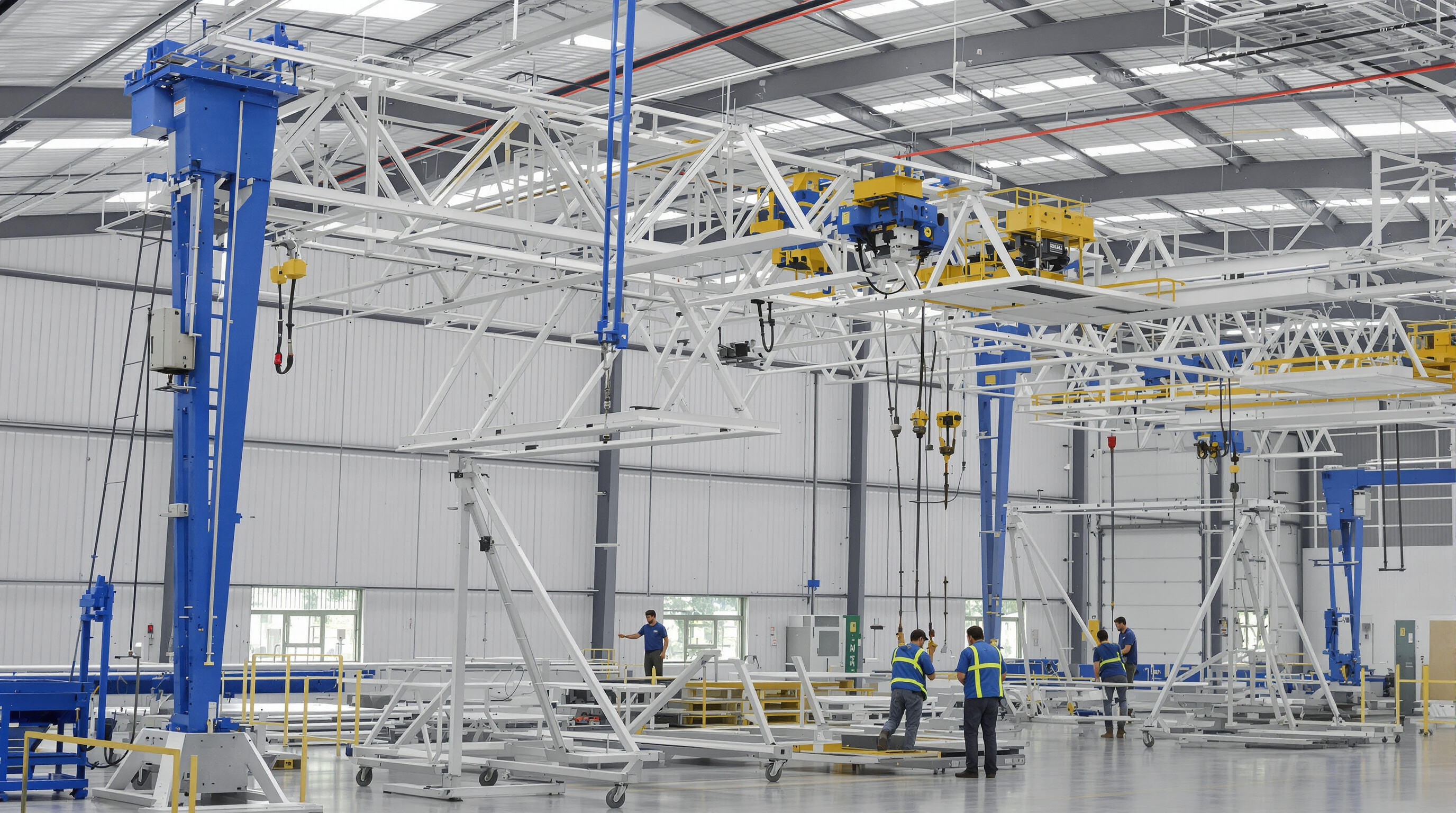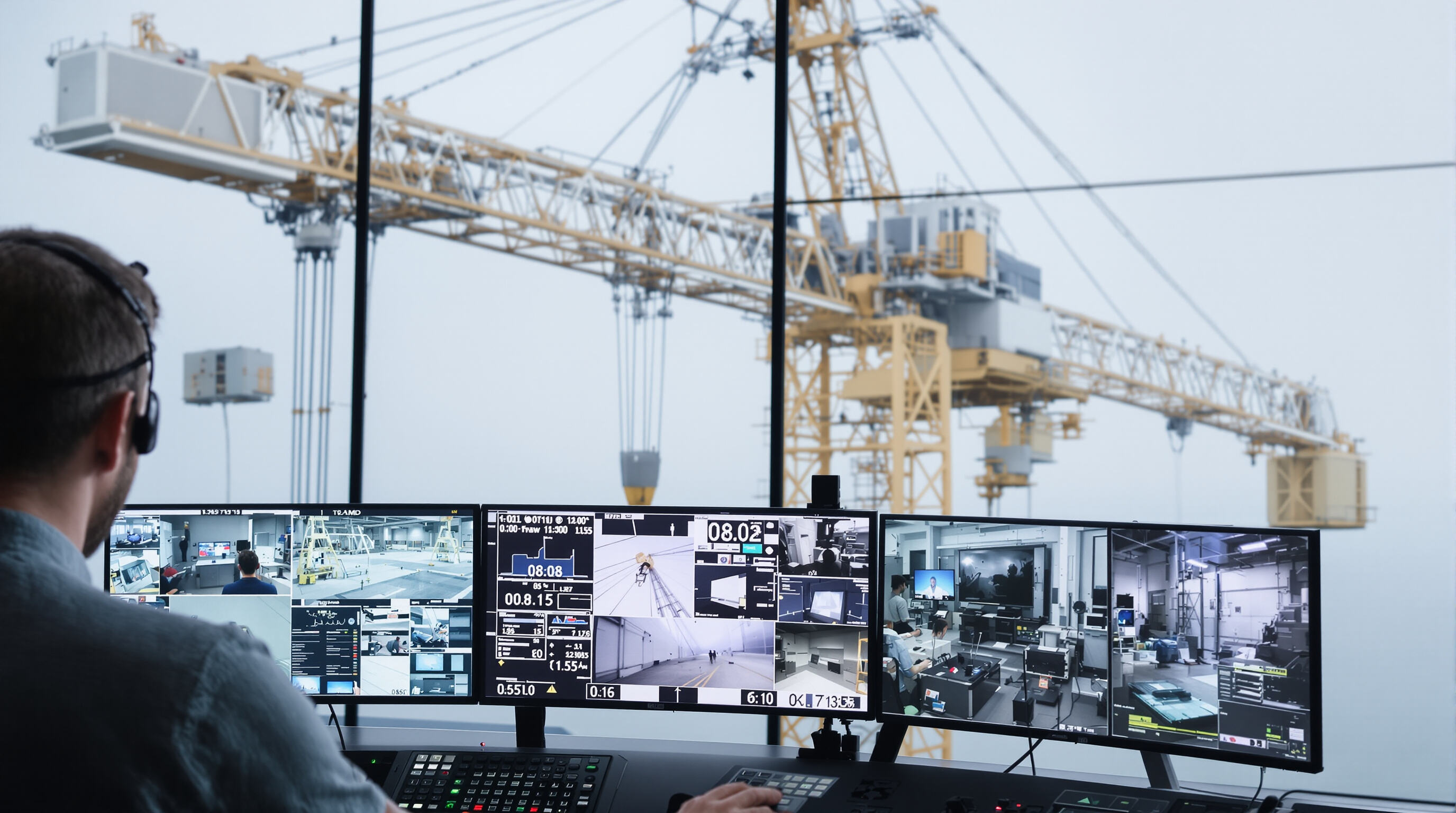Təkamül və üstünlüklər Alüminium port kranı Texnologiya
Poladın alüminiyə keçid: Materialların idarə edilməsi həllərində tarixi dəyişiklik
Materialların idarə edilməsi sahəsində fəaliyyət göstərən müəssisələrin çoxu bu günə qədər köhnəlmiş polad qüllə kranlarından alüminiy sistemlərə keçiblər. Niyə? Əslində, alüminiy poladdan təxminən 40% yüngüldür və təbii olaraq korroziyaya uğramır. Bu isə artıq duzlu su ilə təmasda olan dəniz terminallarında və ya rütubət həmişə yüksək olan yerlərdə işləyərkən qəzəblənəcəyiniz pas problemləri və ya tez-tez texniki baxış tələbləri ilə qarşılaşmazsınız. 2024-cü ilin əvvəlindən olan bazar trendlərinə son nəzərdən keçirilmədə maraqlı bir məqam da aşkar edildi: Yeni kranlar quraşdıran şirkətlərin təxminən 62%-i uzun müddət ərzində xərcləri azaltmaq və dəyişən ehtiyaclarla əlaqədar müxtəlif əməliyyatlarda istifadə üçün tənzimlənə bilən alüminiy variantlarını seçirlər.
Əsas texnoloji inkişaflar alüminium port kranı performans
Bu günə qədər istehsal olunan alüminium portal qaldırıcılar süni intellekt tərəfindən idarə olunan və yükü millimetr dəqiqliyi ilə yerləşdirə bilən smart yük sensorları və simsiz idarəetmə sistemi ilə təchiz olunub. Ekstruziya texnologiyasında olan təkmilləşdirmələr sayəsində bu maşınlar əvvəlkindən daha yüngül qurulsa da, təxminən 10 ton çəkiyə qədər çıxır. Bu da bir neçə il əvvəlki versiyaların tuta biləcəyi həcmə nisbətən üç dəfə çoxdur. Quraşdırılması daha sürətli olan bu konstruksiyada heç bir bolt istifadə edilmir. Ənənəvi dəmir-qurğuşun qaynaq metodu ilə hazırlanmış maşınların quraşdırılması tələb etdiyi vaxtın təxminən yarısı qədər vaxt tələb edir. Bu isə gün ərzində dəyişən şəraitdə işləyən tikinti sahələrində işi xeyli asanlaşdırır.
Niye alüminium mobil və müvəqqəti işlərdə səmərəliliği müəyyən edən amildir
Alüminiumun aşağı sıxlığı tək operatorların 8-metrlik kranları köçürməsinə imkan verir və tikinti layihələrində yanacaq və əmək məsrəflərini 35% azaldır. Onun yorulma müqaviməti struktur deqradasiya olmadan 10.000-dən çox qaldırma dövrünü dəstəkləyir, bu da onu mövsümi loqistika mərkəzləri və müvəqqəti istehsal qurğuları üçün ideal edir.
Tədqiqat nümunəsi: Müasir alüminium sistemlərindən istifadə ilə sənaye loqistikasında məhsuldarlığın artırılması
Böyük loqistika şirkətlərindən biri ağır qurğuşun qövsvari kranları alüminiumdan hazırlanmış xüsusi kranlarla əvəz etdikdə anbar quruluşu üçün tələb olunan vaxt təxminən 30% azaldı. Həmçinin alüminium hissələrin çəkisi çox az olduğu üçün aylıq enerji hesabları da 18% azaldı və işçilər həftəlik dəyişən inventar səviyyələrinə uyğun olaraq əşyaları tez qaytarmaq imkanı əldə etdilər. İki ildən sonra texniki xidmət qeydlərinə baxdıqda daha təsirli nəticə aldıq; alüminium sistemlər yalnız polad olanların tələb etdiyi texniki xidmət və təmirin təxminən 8% -inə ehtiyac duyurdu. Belə fərqlər isə dayanma vaxtı pulla ölçülən operasiyalarda tez arta bilər.
Yüngül dizayn, konstruktiv səmərəlilik və enerji qənaəti
Alüminiumun çəkini azaldaraq möhkəmliyi saxlayarkən daşınmasını necə asanlaşdırdığı
Alüminium portal qaldırıcılar adi polad qaldırıcılardan təxminən 60-70% yüngüldür, bu da onların istifadəsini daha asan edir, lakin möhkəmlik itirilmir. Dəqiq ekstrüziya üsulu ilə hazırlanmış bu qaldırıcılar çəkiyə nisbətən yüksək möhkəmlik göstərir və tikinti sahələrində sürətli quraşdırmanı mümkün edir. Bu cür vaxt itkisinin qənaətə çevrildiyi tikinti sahələrində və ya böyük tədbirlərdə bu xüsusiyyət xüsusilə vacibdir. Həmçinin yüngül olması material xərclərinin azalmasına da kömək edir. Anbar və ya yükləmə dökmələrində çəki məhdudiyyəti olduqda alüminium qaldırıcılar ən yaxşı seçimdir, çünki adi polad qaldırıcılar burada işə yaramır.
Alüminium və polad: konstruktiv və operativ səmərəliliyin müqayisəli analizi
Materialın seçilməsi qaldırıcının iş performansına birbaşa təsir göstərir:
| XƏBƏRDARLIQ | Alüminium | Polad |
|---|---|---|
| Yoğunluq | ~2,7 q/sm³ | ~7,8 q/sm³ |
| Korroziyaya müqavimət | Mükəmməl (öz-özünə passivləşmə) | Örtüklərin tətbiqi tələb olunur |
| Sahənin hazırlanma vaxtı | 40-50% daha tez | Standart |
| İstismar müddəti | 25+ il (az təmir tələb edir) | 15-20 il (müntəzəm təmir tələb edir) |
Alüminiumun korroziyaya davamlılığı rəngləmə tələbini aradan qaldırır və uzunmüddətli təmiri 30% azaldır. Həmçinin, quraşdırma xərclərini və inşaat mühəndisliyi ehtiyaclarını azaltmaq üçün 60% az təkyyüd gücləndirilməsi tələb olunur.
Mobil və sahə quraşdırma tətbiqlərində enerji səmərəliliyi faydaları
Yüngül avadanlıqlar işə salındıqda və hərəkət edərkən enerji istifadəsini 15-dən belə 20 faizə qədər azalda bilər, həmçinin istifadə üçün tələb olunan yanacaq ehtiyacı 35% qədər azala bilər. Şəbəkədən uzaq olan bu cür məntəqələrdə generatorlardan asılı qalan istifadəçilər üçün bu cür səmərəlilik həm xərcləri, həm də ekoloji izi azaldığı üçün vacibdir. Davamlılıq amillərinə baxanda da maraqlı bir məqam aşkar olunur: alüminium konstruksiyaların istehsalından istifadəyə qədər olan müddətdə yaydığı karbon tullantıları alətlərin ömürləri boyu təxminən dəmir konstruksiyalara nisbətən yarı qədərdir. Bunun əsas səbəbi alüminiumun daha asan təkrar emal olunmasıdır və ümumiyyətlə istehsal və istifadə prosesində daha az enerji ilə daha yaxşı işləməsidir.
Dinamik Sənaye Tələbləri Üçün Modulyar və Ölçəklənəbilən Həllər

Müasir Alüminium Gantry Kran Sistemlərində Modulyarlığın Əsasları
Modulyar alüminium qüllə qaldırıcılar sürətli quraşdırma və yenidən qurulma üçün standartlaşdırılmış birləşmə nöqtələrindən və dəqiq ekstrüzyonlardan istifadə edir. Sərt metal konstruksiyalardan fərqli olaraq, onlar dəyişən sahə tələblərinə tez uyğunlaşır. 2023-cü ilin sənaye avadanlıqları araşdırması göstərmişdir ki, bu sistemlərdən istifadə edən müəssisələr konvensiya qurğularla müqayisədə quraşdırma vaxtını 43% qədər azaltmışdır.
Müxtəlif Sənaye Konfiqurasiyaları üçün Fərdiləşdirmə Seçimləri
Açıqların tənzimlənməsi (3–15 metr) və qaldırma tutumlarının (1–20 ton) olması alüminium qüllə qaldırıcıları kosmik sənaye, bərpa olunan enerji və avtomobil sektorlarına uyğun hala gətirir. Konsol uzadıcılar və tənzimlənən ayaqlar kimi konstruksion əlavələr struktur dəyişiklikləri olmadan sahəyə xas problemləri həll edir.
Tədqiqat Nümunəsi: Modulyar Dizaynlardan İstifadə edərək Müvəqqəti Sahələrdə Sürətli Tətbiq
İstehsalçı, müvəqqəti loqistika mərkəzində modulyar alüminium qopurucular quraşdırdı və onların quraşdırılması polad konstruksiyalara nisbətən 65% daha tez başa çatdı. Sistemin 1,250 kq/m³ yüklənmə-çəki nisbəti – müqayisə edilən polad modellərə nisbətən 33% yüksəkdir – qeyri-bərabər ərazidə təhlükəsiz işləməni təmin etdi və gələcək köçürlər üçün daşınmasını saxladı.
Məlumatla idarə olunan materialların idarə edilməsinin genişləndirilməsi və tənzimlənməsi ilə əməliyyatların gələcəyə hazır olması
Əsasən 2023-cü il modulyar infrastruktur hesabatına əsasən sənaye operatorlarının 78%-i materialların idarə edilməsi sistemlərini modernləşdirərkən genişlənmə imkanlarını prioritet hesab edir. Alüminium qopru qopurucuları isə çoxmərtəbəli komponentlər və proqram idarəetməli yüklərin tarazlaşdırılması vasitəsilə mərhələli genişlənmələri dəstəkləyir və bu da inkişaf mərhələlərində tam sistemlərin dəyişdirilməsi xərclərini aradan qaldırır.
Avtomatlaşdırma, idarəetmə və məlumatlara əsaslanan performans

Avtomatlaşdırma və ağıllı texnologiyaların alüminium Qüllü Kranlar
Müasir alüminium qülləli kranlar IoT sensorlar və AI alqoritmlərini birləşdirərək yükün yerləşdirilməsini, toqquşmadan qaçınmağı və iş prosesinin optimallaşdırılmasını avtomatlaşdırır. Maşın öyrənmə dəyişən yüklərə və mühitə uyğunlaşmanı təmin edir və sahə sınaqlarında əməliyyatın 18–22% qədər daha sürətli olmasını təmin edir.
Təhlükəsizlik və səmərəliliyin artırılması üçün uzaqdan izləmə və dəqiq idarəetmə
Operatorlar real vaxtda yük göstəricilərini, ətraf mühit şərtlərini və təhlükəsizlik zonalarının xəritəsini göstərən mərkəzləşdirilmiş panel vasitəsilə bir neçə kranı idarə edirlər. Uzaqdan idarə etmə şəxsi heyətin təhlükəli zonalarda olma müddətini 67% azaldır, şifrələnmiş 5G əlaqəsi isə santimetrdən kiçik dəqiqliklə yer təyin etməyə imkan verir.
Real vaxt rejimində məlumatlar və proqnozlaşdıran analitika vasitəsilə performansın optimallaşdırılması
Təqdim 2024-cü ilin Sənaye Avtomatlaşdırılması Hesabatı qeyd edir ki, alüminium portal sistemləri proqnozlaşdırıcı texniki xidmət göstərmə ilə 92,4% istismar mövcudluğuna nail olur - ənənəvi modellərdən 15% yüksəkdir. Əsas xüsusiyyətlərə yataq nasazlıqlarını 30-50 saat əvvəl proqnozlaşdıran vibrasiya analizi və qismən yüklənmə zamanı enerji istehlakını 21% azaldan adaptiv enerji idarəetmə daxildir.
Avtomatlaşdırılmış material daşıma sistemlərində kiber təhlükəsizlik narahatlıqlarının həlli
AES-256 şifrələmə, biometrik giriş nəzarəti və qeyri-müəyyən giriş cəhdlərini 15 saniyə ərzində 98,7% müəyyən edən invaziya aşkarlama sistemləri qaldırıcı şəbəkələri qoruyur (NIST 2023 meyarları). Çoxqatlı autentifikasiya yalnız 5 tondan artıq olan qaldırma qurğularını yetkili şəxslərin idarə etdiyindən əmin olur.
Tətbiqlər, mobillik və müasir əməliyyatlarda davamlılıq
İnşaat, loqistika və tədbirlərin təşkili mühitlərində mobilliyin üstünlükləri
Alüminium portalı kranlar iş yerlərində asanlıqla hərəkət etmək qabiliyyəti ilə tanınır. Daha yüngül çəkisi bu kranların bir yerdən digərinə çox tez köçürülməsini təmin edir, istər tikinti sahəsinin müxtəlif hissələri arasında, istər anbar yerlərində, istərsə də qısa müddətli tədbir yerlərində. Bu çeviklik onları vaxt az olduğu zaman çox dəyərli edir. Maraqlısı odur ki, onlar ənənəvi polad modellərlə müqayisədə daha tez parçalanıb yenidən birləşdirilə bilərlər. Bəzi hesablamalara görə, montaj vaxtları təxminən üçdə iki azaldır, bu da işçi xərclərini əhəmiyyətli dərəcədə azaldır. Bu sürət məhdud yerin olduğu və daha böyük maşınların dar küçələrdə və ya kompakt iş yerlərində yerləşməyəcəyi şəhərlərdə də çox vacibdir.
Əsas sənaye qurğularından real dünya performansına dair anlayışlar
Müxtəlif zavodlardakı real işlədilmələrə baxdıqda alüminium konseptli qüllələr tez-tez otuz faiz qədər quruluş vaxtını azaldır, ənənəvi steel sistemlərlə müqayisədə, habelə nəqliyyat xərclərini təxminən iyirmi beş faiz azaldır. Bu qüllələr xüsusilə avtomobil istehsalı xətlərində və gəmi təmiri zavodlarında işləmək üçün əlverişlidir, burada məkan məhdud və tavan aralığı məhdudlaşmışdır. Kompakt dizayn onları istehsalat sahələrinin müxtəlif hissələrində daşımaq üçün ideal edir. Maraqlıdır ki, bu sistemlər gün ərzində iş stansiyaları arasında tez-tez köçürüldükdə belə, sabit performans səviyyəsini saxlayır, bu isə ağır sabit qurğular üçün çətinlik yarada bilər.
Enerjiyə qənaət edən dizayn və ömür dövrü analizi vasitəsilə əldə edilən davamlılıq göstəriciləri
Alüminiumun möhkəmlik-çəki nisbəti nəqliyyat yanacağı sərfini 40%-ə qədər azaldır. Korroziyaya davamlılıq minimal texniki xidmət tələb edərək istismar müddətini 20 ildən artıq uzadır və istifadə müddətinin sonunda komponentlərin 95%-i təkrar emal olunur - bu da dairəvi iqtisadiyyat məqsədlərinə kömək edir. Bu xassələr birlikdə materialların emalı əməliyyatlarının ümumi ekoloji izini azaldır.
Ətrafə dostu və davamlı tavanüstü materialların emalında mövcud olan yeni tendensiyalar
Təkrar istifadəyə gətirən sürət qutuları və günəş enerjisi ilə işləyən köməkçi qurğular kimi yeni texnologiyaların tətbiqi ilə qaldırma qurğularının işləri daha ekoloji cəhətdən təmiz hala gəlir. Bir çox istehsalçılar indi qaldırma qurğuları üçün əvəz olunan alüminium ərintilərinə keçid edirlər. Bu ərintilər yüklərin böyük hissəsini etibarlı şəkildə dəstəkləyir və eyni zamanda istehsal emissiyalarını təxminən üçdə iki qədər azaldır, çünki bütün şeylər təbii materiallardan sıfırdan hazırlanır. Gələcəkdə qaldırma qurğuları karbon sensorları ilə təchiz oluna bilər ki, bu da emissiyaları real vaxtda izləyəcək və enerji istifadəsini avtomatik olaraq optimallaşdıran ağıllı sistemlərlə işləyəcək. Lakin bu təkmilləşdirmələrin sənaye boyu yayılması şirkətlərin ilkin xərcləri ilə uzunmüddətli ətraf mühit faydaları arasında tarazlıq yaratması ilə bir gecədə baş verməyəcək.
عمومی سواللار بؤلومو
Nəzərdə tutulan əsas üstünlüklər nələrdir alüminium port kranı s over steel cranes?
Alüminium qapı tipli qaldırma qurğuları daha yüngül, daşınmaq üçün daha yararlı, korroziyaya davamlı və polad qaldırma qurğularına nisbətən daha az təmir tələb edir. Bundan əlavə, onlar enerji səmərəliliyi təmin edir və müxtəlif sənaye ehtiyacları üçün tənzimlənməsi və modulyar şəkildə hazırlanması asan olur.
Necə İşləyir alüminium Qüllü Kranlar contribute to sustainability?
Alüminium portal qaldırıcılar yanacaq sərfini azaldır, daha yüksək bərpa dərəcəsinə malikdirlər və onların istismarı zamanı atmosferə zərərli tullantılar az olur. Bu cür qaldırıcılar ekoloji cəhətdən təmiz və davamlı materialların idarə edilməsi üçün əsas vasitədir.
Ola alüminium port kranı ağır işlərdə istifadə edilə bilərmi?
Bəli, müasir alüminium portal qaldırıcılar ekstruziya texnologiyasının inkişafı və ağıllı yük sensorları sayəsində əhəmiyyətli çəkiləri qaldırmaq üçün nəzərdə tutulmuşdur, burada hər birinin buraxılış qabiliyyəti 20 tonadək çatır.
Mündəricat
-
Təkamül və üstünlüklər Alüminium port kranı Texnologiya
- Poladın alüminiyə keçid: Materialların idarə edilməsi həllərində tarixi dəyişiklik
- Əsas texnoloji inkişaflar alüminium port kranı performans
- Niye alüminium mobil və müvəqqəti işlərdə səmərəliliği müəyyən edən amildir
- Tədqiqat nümunəsi: Müasir alüminium sistemlərindən istifadə ilə sənaye loqistikasında məhsuldarlığın artırılması
- Yüngül dizayn, konstruktiv səmərəlilik və enerji qənaəti
-
Dinamik Sənaye Tələbləri Üçün Modulyar və Ölçəklənəbilən Həllər
- Müasir Alüminium Gantry Kran Sistemlərində Modulyarlığın Əsasları
- Müxtəlif Sənaye Konfiqurasiyaları üçün Fərdiləşdirmə Seçimləri
- Tədqiqat Nümunəsi: Modulyar Dizaynlardan İstifadə edərək Müvəqqəti Sahələrdə Sürətli Tətbiq
- Məlumatla idarə olunan materialların idarə edilməsinin genişləndirilməsi və tənzimlənməsi ilə əməliyyatların gələcəyə hazır olması
-
Avtomatlaşdırma, idarəetmə və məlumatlara əsaslanan performans
- Avtomatlaşdırma və ağıllı texnologiyaların alüminium Qüllü Kranlar
- Təhlükəsizlik və səmərəliliyin artırılması üçün uzaqdan izləmə və dəqiq idarəetmə
- Real vaxt rejimində məlumatlar və proqnozlaşdıran analitika vasitəsilə performansın optimallaşdırılması
- Avtomatlaşdırılmış material daşıma sistemlərində kiber təhlükəsizlik narahatlıqlarının həlli
-
Tətbiqlər, mobillik və müasir əməliyyatlarda davamlılıq
- İnşaat, loqistika və tədbirlərin təşkili mühitlərində mobilliyin üstünlükləri
- Əsas sənaye qurğularından real dünya performansına dair anlayışlar
- Enerjiyə qənaət edən dizayn və ömür dövrü analizi vasitəsilə əldə edilən davamlılıq göstəriciləri
- Ətrafə dostu və davamlı tavanüstü materialların emalında mövcud olan yeni tendensiyalar
- عمومی سواللار بؤلومو

